The Museum Blog
Category: Enriching Experiences
Make a Bird Kite!
by Meredith Brustlin, CMNH Educator
The craft I have to share with you today is making a bird kite! This is a really simple activity that you can do with a handful of household items - and it will (hopefully) supply your little ones with a whole bunch of fun.
This awesome activity was found on www.krokotak.com - browse their website for a variety of other fun activities that use simple materials you can find at home, mostly paper!
Materials Needed:
- Piece of 8.5 X 11 paper
- 2-3 Sticky notes
- Or pieces of colorful scrap paper and a glue stick or tape, I like the sticky notes because they are self adhesive!
- Stapler, scissors, hole punch
- Markers, stickers, any other decorations you’d like
- String/ribbon/yarn
Instructions:
- Fold a piece of paper in half
- Gently “swoop” down both sides to form the wings of your bird and attach with one staple
- Punch a hole on the bottom for the kite string
- Cut a sticky note to make a beak and tail feathers--feel free to add other decoration using markers
- Add some sticker eyes
- Attach the string - you’re ready to fly!
Polymer Science MAGIC!
Materials Needed:
- Large mixing bowl or container (a casserole pan would work!)
- Plastic bag (I recommend quart size) filled ¾ of the way with water
- A bunch of pencils or colored pencils--the sharper the better!
Directions (prep):
- Fill your plastic bag ¾ of the way with water
- You may want to fill a few because this experiment is very fun!
- Sharpen your pencils
- Prep the activity area with the bowl or casserole pan
Directions (activity):
- Ask your young scientists if they think you can poke a pencil through a bag of water without spilling a drop (they will probably say “No way!”)
- Hold the bag up over the bowl or other container
- Carefully twist a pencil through one side of the plastic bag and then continue to twist through the other side
- No water will spill!
- Try it with the other pencils
Invite your young scientists to try on their own using bags of water and pencils
The Science:
- Plastic bags are made of something called a polymer
- Polymers have long strings of molecules that are flexible
- When you poke the pencil through the plastic bag, it wiggles in between these strings of molecules and the molecules seal up around the pencil so that no water is spilled!
Extend the learning:
- Spend some time looking on the internet for other household items that are polymers - you’ll be surprised by what you find!
Tinker Time at Home!
by Meredith Brustlin, CMNH Educator
Every week at the Children's Museum of New Hampshire we host a program called “Tinker Time”. Tinker Time is a drop-in program that emphasizes the importance of tinkering! Tinkering helps children develop fine motor skills, increase problem-solving abilities, and is an open invitation to foster peer relationships.
What I love about tinkering is that it’s open-ended and no-fail. The carefully selected activities are designed to have many possible solutions and ways to explore. This means that children with different learning styles, who are different ages, and have different interests can all get something out of these activities.
I usually set up the tinkering program with five different activity areas: Art Material Creations, Sorting, Building, Sensory/Texture Play, and Cause & Effect Exploration. I’m sharing one activity from each of these categories, but please don’t feel like you have to set-up all of them to have a successful tinker time! Set up one or two - use these activities as jumping off points and then tweak it to match the supplies you have at home or your own child’s interests - it’s totally up to you!
Enjoy tinkering!
Art Exploration: Sticker drawing prompts
- Place round tickers (or draw round circles with different colors) on index cards or pieces of paper. Invite your child to use the placement of the dots to make a picture!
- Try putting the same configuration of dots on several pieces of paper and have a “draw-off” with the whole family - see how different your drawings are even though you were given the same prompt!
Sorting: Color sorting
- Gather lots of different art materials from around your house (markers, permanent markers, crayons, hi-lighters, colored pencils) and invite your child to sort them.
- Will they sort them by color? By type of art material? By size?
- Invite children to try and make a pattern using the colorful art materials!
Building: Cup towers w/ manipulatives
- Collect plastic cups from around your house
- Find some small manipulatives - little animal or people toys.
- Build homes for the animals or build fences around them. Hide little people in the cups and guess where they are.
- See who can make the tallest tower!
- Build a tall tower and then throw a ball at it to knock it down!
Sensory/Textures: Cars on Salt
- Sprinkle salt all over a cookie sheet or other container
- Use toy cars, toy animals, or just hands to explore the salt and make designs!
Cause & Effect: Is it magnetic?
- Collect small items that are either magnetic..or not magnetic...and place them in a container
- Find a magnet on your fridge that is powerful enough to pick up some small items
- For younger children: test and see which of the items are magnetic! How many items were you able to pick up using the magnet?
- For older children: invite them to pre-sort the items into piles of items they think will be magnetic and ones that they do not think will be magnetic. Use the magnet to test their predictions!
Exploring Our Way turns 8!

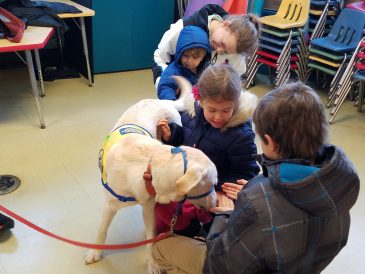
If you were visiting the Museum on Sunday morning March 4th, you might have been surprised to see half a dozen golden Labradors Retrievers strolling around. These dogs, mostly 10-11 month old puppies, are in training to become skilled canine companion dogs. ‘Puppy raisers’ and their charges visited Exploring Our Way to share information with families about the Canine Companions for Independence Program, which provides trained dogs to work with an adult or child with a disability, including Autism Spectrum Disorder.
The Children’s Museum of New Hampshire’s Autism Partnership Program, Exploring Our Way, debuted in March 2010 after many months of planning with a dedicated committee of advisors. Since then, the museum has opened its doors one Sunday per month exclusively for families raising a child on the autism spectrum. Exploring Our Way offers a quieter, less crowded environment in which to explore museum exhibits with the goal of providing the best opportunity for a successful museum visit. Siblings are invited too, so the entire family can enjoy a fun outing together.
In the safe and welcoming surroundings of the Children’s Museum children with Autism Spectrum Disorder explore at their own pace, become familiar with the museum’s exhibits, and may feel comfortable enough to increase the length of time of their visit. We invite families to consider visiting during public hours, if their child is comfortable enough, and give them free admission passes in case they want to make the transition.
We also introduce families to new resources and services, like Canine Companions for Independence, by inviting representatives to come to Exploring Our Way and share information with parents. Check the Exploring Our Way page on our website and Facebook to learn more about upcoming special guests.
Exploring Our Way will not happen on April 1st as the Museum will be closed for Easter Sunday. We look forward to seeing you on May 6th!
Visiting Artist Week
By Meredith Lamothe, CMNH Early Childhood & Literacy Coordinator
I love art. I love going to art museums and looking at masterpieces—I always have. I’m pretty crafty and have managed to make some art-like creations. I enjoy coming up with activities in our Muse Studio and finding ways to make them about the process of art rather than the final product (a subject that deserves its own blog post!). As I sit at my desk right now, I see Experience Guide Amanda outside doing our “Chalk Art” kit—no visitors have joined her yet, but she’s happily drawing a lovely rainbow near the entrance to the museum.
There’s just something about art, isn’t there? It can be whatever you want it—or need it—to be. For Amanda right now, it’s a calm moment before she gets back to her many tasks inside the museum. I’m more of a crafter and get a lot of joy from giving finished crafts to people I love. Art can be purely fun (have you seen the projects where you throw water balloons at a blank canvas?!). Art, especially with kids, can be a great way to visually see some of the fascinating growth that is happening—from drawings of stick figures with arms coming out of their heads, to beautiful clay sculptures and beyond.
As fun as art is on it’s own, just for yourself, it’s also great to have skilled instructors help out sometimes. They open our eyes to different art forms we may not have thought about before, introduce new materials to use to create, and have an abundance of knowledge and encouraging words to share.
And what do you know, lucky us, we have five incredible instructors visiting the museum next week! We’re thrilled to announce our first ever Visiting Artist Week here at The Children’s Museum of New Hampshire.
We will have five wonderful local artists joining us for workshops the week of July 24-28, 2017. A few of these artists were guests at our “Visiting Artist Camp” last year and the final products that those campers produced were nothing short of remarkable.
Workshops will be from 11am - noon each day and are included with museum admission and free for members. Workshops may be best for children 6 years old or older, but would be fine for younger children with some help.
Monday, July 24th: Neva Cole
Neva, the Communications Director here at the museum, will encourage families to tear up, rip, cut and glue painted paper into collaged sea monsters! If a mermaid or pirate find their way into your scene, even better!
Neva is a multimedia artist and illustrator who is not the least bit ashamed to admit she spends a ridiculous amount of time with paint on her hands.
Tuesday, July 25th: Tess Feltes
Tess, the curator of Gallery 6 here at the museum, will be sharing some of her watercolor knowledge! Did you know all birds start from eggs? Of course you did! But! Did you know that bird paintings start with egg shapes?
Learn to draw and paint birds using simple geometric shapes with Tess!
Tess has illustrated numerous scientific books and articles and she is going to share some tricks of the trade.
Wednesday, July 26th: Cindel Lamothe
Cindel, an expert seamstress, will be here explaining a bit about the process of sewing—from patterns to fabric to putting it all together into a fabulous final product! What will be the final product of your hard work on the 26th? An adorable felt dinosaur that you can put on a pillow, apron, or frame and put on your wall!
Thursday, July 27th: Gina Perry
Learn how to draw imaginary creatures with children's book illustrator Gina Perry. She will show you, step-by-step, how to draw a Unicorn, Bigfoot, Loch Ness Monster, and a Mermaid. Watch out - you might even learn how to draw a Dragon!
Friday, July 28th: Francois Lamothe
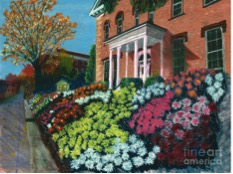 Seacoast pastel & acrylic painter Francois Lamothe will be here to share his skills. Francois will be sharing some tips and tricks about painting flowers using chalk pastels! Be sure to come prepared to get messy—this unique art experience is sure to accidentally travel onto clothing (it’s washable!)
Seacoast pastel & acrylic painter Francois Lamothe will be here to share his skills. Francois will be sharing some tips and tricks about painting flowers using chalk pastels! Be sure to come prepared to get messy—this unique art experience is sure to accidentally travel onto clothing (it’s washable!)
We hope you will join us for a day or two of Visiting Artist Week. It’s sure to be a lot of fun and you’ll learn some unique new skills as well.
Oh! In case you’re interested, some visitors have joined Amanda and her chalk outside now and have added frogs, fish, a yellow submarine, and some very large flowers alongside her rainbow!
A Working Parent’s “Summer”
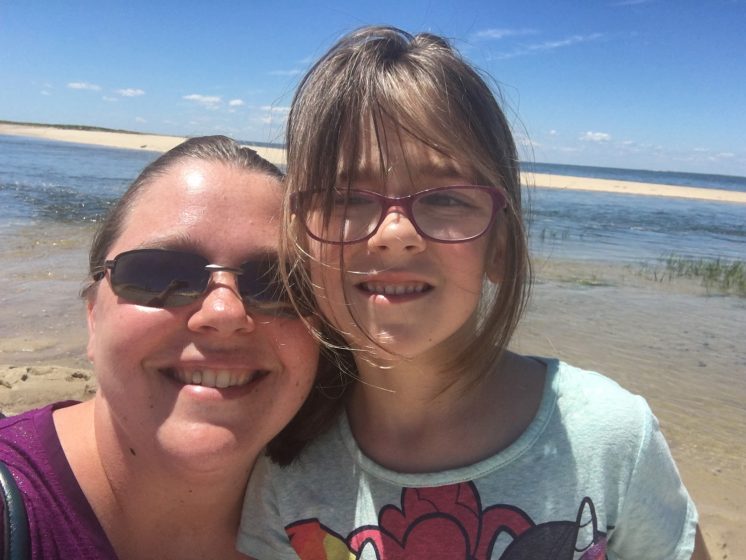
By Neva Cole, CMNH Communications Director
When I hear people talk about summers with their kids it always sounds so idyllic to me: long days spent lounging on the beach; trips to local attractions; camping with family and friends. If I were to take people’s Facebook feeds at face value, pun intended, I’d think there was something seriously wrong with my summer parenting skills.
I’m a working parent, and so is my husband. My daughter has been in a year-round daycare, so she hasn’t experienced “summer break” yet. We’ve gotten used to squeezing summer fun into the afternoons and weekends. But that’s all going to change soon with the start of kindergarten in her local school this Fall. I’m about to become one of the parents that will have to plan way in advance on how to schedule work around camps, squander vacation days to spend a few precious long weekends on a lake somewhere, and probably start to butter up the grandparents for when plans inevitably fall through.
I’m not really complaining. I know how lucky we are. I’m a little jealous of my daughter getting to experience summer break, where the days seemed like endless adventures. I wish I could spend every minute with her out in the sun, gardening, swimming and blowing bubbles. But we all do the best we can. And my best is being there with her in the moments we have together, and making sure she’s surrounded by love and engaging her brain and her creative muscles when I’m not there.
New Hampshire is teeming with opportunities for kids to grow and learn in the summer. All the great cultural institutions like the Currier Museum of Art, the Seacoast Science Center, the SEE Science Center, Audubon centers and yes, the Children’s Museum of New Hampshire have fantastic camps, programs, events and workshops for kids of all ages. And many bend over backwards to help parents make their children’s summers memorable and affordable. These non-profits are here to be a resource to you, and I hope you use them this summer and many summers to come. I know I will.
Parents interested in the Children’s Museum of New Hampshire’s summer camps can choose from 3-day Mini Camps for ages 4-6 (which are all full as of today) or 5-day Discovery Camps for ages 7-11.
Growing Ice
by Dan Cox, CMNH Experience Guide
Snowy days might mean no school, but it doesn’t mean that there is nothing to learn. Snow-covered sidewalks helped me learn that salt can melt ice. At the time I didn’t know it was because it lowers the freezing point of water, but I saw the results firsthand through inquiry and observation. I also learned how to use a snow blower, even if I got snow all over my neighbor’s windows. Either way snow days are still an opportunity for learning and here is an experiment you can try.
You will need:
-A couple bottles of water
-A plastic container (You can do it with a small Tupperware but it could probably work with a party cup or even a bowl. You want something that has some room in case of spills)
-Some ice cubes
-Food coloring (Optional for fun colors)
 1. First you want to put the bottles of water in the freezer, if you decide to add food coloring make sure to screw the cap on tightly.
1. First you want to put the bottles of water in the freezer, if you decide to add food coloring make sure to screw the cap on tightly.
2. Leave the bottles in the freezer for about 2 Hours and 45 Minutes. Check them regularly because you don’t want them to freeze. (When I used to do hiking in the winter, I would place my water bottle upside down. Ice floats {because it’s less dense} and it will freeze from the top down)
3. When the water in the bottles is super cold, but not frozen, take them out of the freezer.
4. Next you want to place some ice cubes in the plastic cup.
5. Then pour the cold water on the ice.
6. Observe what happens, will the water melt the ice? Will the ice freeze the water?
Here is a youtube video of someone else trying this experiment:
Happy New Year!
by Rebecca Scheinberg, CMNH Intern
We are officially in 2017. We made it to a brand new year filled with possibilities. The New Year provides an opportunity for reflection and resolutions. It is a blank slate. It is a chance for new discovery, innovation, and creativity.
At the end of 2016, we asked you to join us in sharing your wishes for the New Year. As part of our Family New Year’s Eve celebration, visitors created ‘wish blimps’ that they launched off our 30-foot vertical, hand-powered conveyor system known as 'Build It, Fly It.'
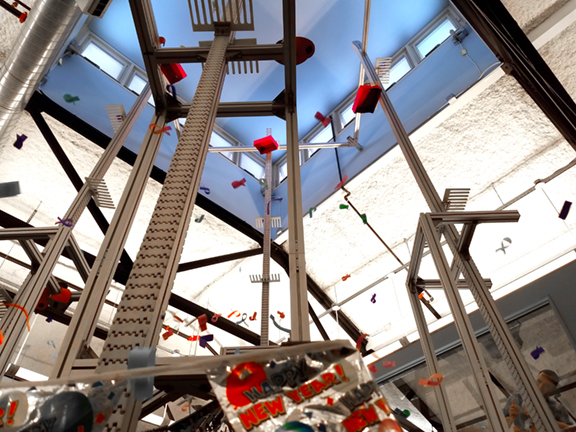
Your wishes ranged from getting a pet guinea pig to peace on earth, from being able to fly, to...pancakes. Someone wished for a baby sister or brother and someone else wished that their baby sister would stop crying so much. One visitor wished for nachos, and another wished for her frosty the snowman to come to life. Another friend wished for snow. We are nearly two weeks into the New Year and this one has already come true!
These are some of your wishes:
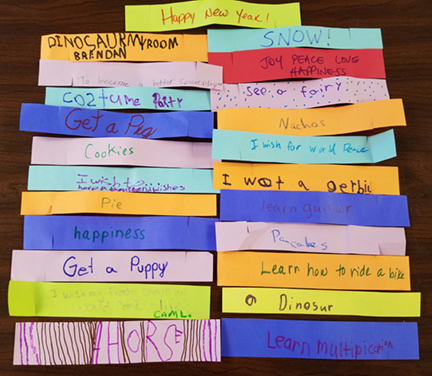
We had a wonderful time playing and exploring with you in 2016. This year, we already have a new exhibit and many exciting upcoming events. We hope you will visit us soon to play. May this year bring even more adventure, exploration, love and kindness to all.
We hope all your wishes come true.
